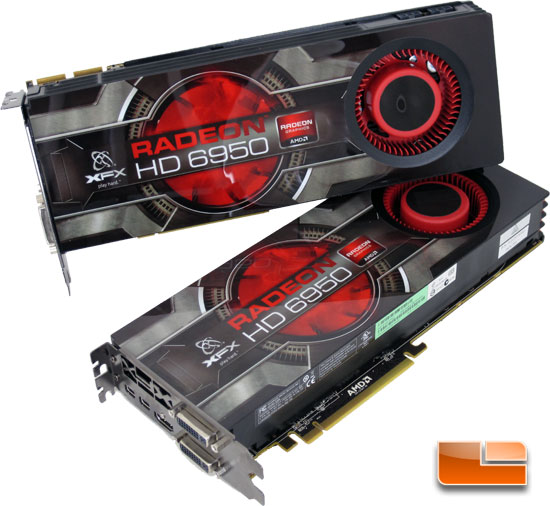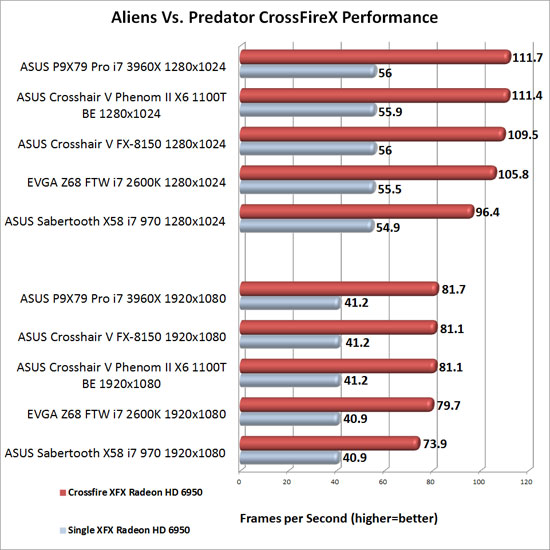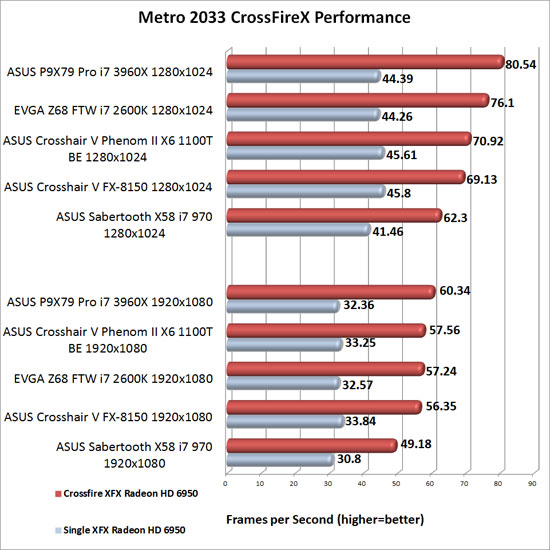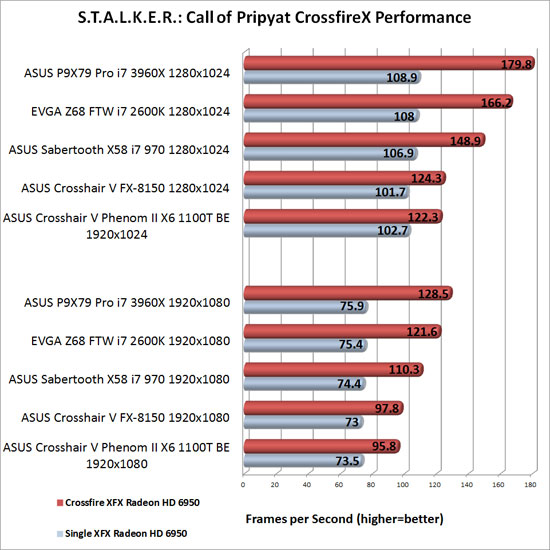ASUS P9X79 Pro Intel X79 Motherboard Review
AMD CrossFire Gaming Performance

As with the previous page where we tested the NVIDIA SLI scaling between the chipsets, we want to do the same for the AMD CrossfireX. When we decided to run this series of tests, we were able to get in touch with our friends over at XFX and they kindly sent over a pair of XFX Radeon HD 6950’s.

The Aliens Vs. Predator benchmark is very dependent on the graphics cards being used. Across all of our platforms the single card score varies very little. It isn’t until we fire up the systems in AMD CrossFireX that we start to see a difference in the performance. At the lower resolution of 1280×1024 the ASUS P9X79 Pro was able to average 111.7 frames per second followed closely by the ASUS Crosshair V Formula with the AMD Phenom II X6 1100T BE with 111.4 frames per second. The previous generation Intel X58 “enthusiast” platform had the lowest performance scaling with 96.4 frames per second. Increasing the resolution to 1920×1080 the ASUS P9X79 Pro maintains the lead with an average of 81.7 frames per second, followed once again by the ASUS Crosshair V Formula as both of the processors were able to hit 81.1 frames per second. Our Intel X58 platform once again brought up the back of the pack with 73.9 frames per second.

If we were to look solely at the single card performance of the systems the ASUS Crosshair V Formula with either the Phenom II X6 1100T or AMD FX-8150 would have the slight lead. Though just about all of the systems were within about 1.5 frames per second. The exception to this is the ASUS Sabertooth X58 system which was ~5 frames per second behind at 1280×1024 and 3 frames per second at 1920×1080. Once we tossed in the second XFX Radeon HD 6950 for a little CrossFireX action, we started to see the different platforms stand apart. The ASUS P9X79 Pro was able to scale 81.4% going from 44.39 frames per second to 80.54 frames per second. The Intel X58 system saw a performance gain of only 50.3% while our Intel Z68 platform saw a gain of 71.9%. Running the Metro 2033 benchmark at 1920×1080 the ASUS P9X79 Pro saw a performance gain of 86.5%. The Intel X58 saw a gain of 59.7% and the Intel Z68 saw a gain between the two of them at 75.7%.

Our Intel systems clearly dominated in S.T.A.L.K.E.R.: Call of Pripyat. The Sandy Bridge and Sandy Bridge E platforms were able to maintain a solid lead over the previous generation Intel X58 system. Running our benchmark at 1280×1024 all of the Intel systems were within less than 2% of each other with a single XFX Radeon HD 6950, once we set up our AMD CrossFireX configurations we saw the game change. The ASUS P9X79 saw a gain of 65.1%. This is an improvement over what we saw over the previous generations, where the Intel X58 saw a gain of 39.3% and the EVGA Z68 FTW saw a gain of 53.9%. When we run the benchmark at 1920×1080 the ASUS P9X79 continues to dominate the field of battle. Once again all of the single card performances show minimal differences, AMD CrossFireX scaling is a totally different story. In CrossFireX the ASUS P9X79 Pro hit an average framerate of 128.5 frames per second, the EVGA Z68 FTW wasn’t far off with 121.6 frames per second or 61.3% and the ASUS Sabertooth X58 maintained an average of 110.3 frames per second which is a gain of 48.3%.

Comments are closed.